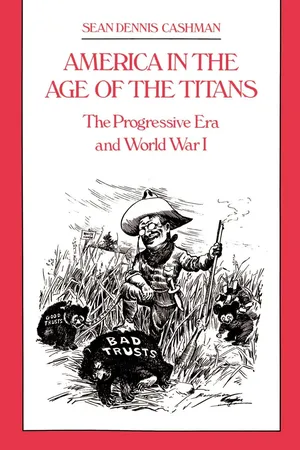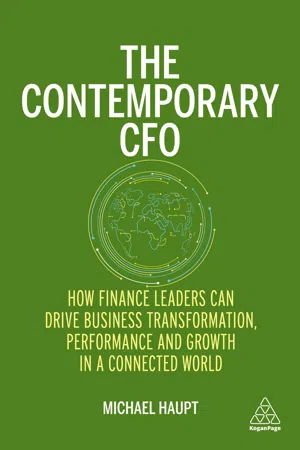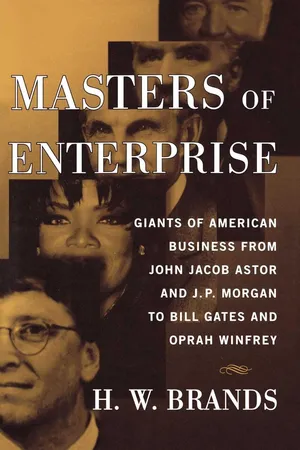Technology & Engineering
Henry Ford
Henry Ford was an American industrialist and the founder of the Ford Motor Company. He revolutionized the automobile industry by implementing assembly line production, making cars more affordable and accessible to the general public. Ford's innovative approach to manufacturing and his introduction of the Model T car played a significant role in shaping the modern automotive industry.
Written by Perlego with AI-assistance
Related key terms
Related key terms
1 of 4
Related key terms
1 of 3
5 Key excerpts on "Henry Ford"
- eBook - ePub
America in the Age of the Titans
The Progressive Era and World War I
- Sean Dennis Cashman(Author)
- 1988(Publication Date)
- NYU Press(Publisher)
The auto industry encouraged innovations in various tributary industries. Because cars ideally required lighter metals, the steel industry developed various alloys. The need for more durable tires encouraged the rubber industry to make better wearing materials; the need for tougher glass stimulated production of shatterproof glass. The call for higher-powered fuel continuously stimulated the petroleum industry to refine ethyl and high-octane gasoline. The earliest automobile fuel was composed of those fractions of crude oil that were too light to be included in kerosene and had previously been considered unsalable. The development of the cracking process in the 1920s was a major improvement in oil refining. Cracking consisted of heating surplus heavier oils under pressure and thereby cracking, or splitting, their large molecules into small ones that form the lighter, more valuable fractions. After suitable chemical treatment, gasoline manufactured by cracking performed better in automobile engines than gasoline derived from straight distillation. In addition, the new industry became a major market for tin, copper, felt, leather, and sundry other products. Perhaps the greatest gains were in road construction. Whereas the states spent a total of $75 million on highway construction in 1918, in 1932 they were spending over $1 billion a year.The United States’ major contribution to automobile manufacture was the system of mass production. In fact, mass production with its special emphasis on standardization and interchangeability of parts was not only suited to the United States but also essential. For, although the American population was large and its potential market considerable, it was also widely dispersed, thus needing such an invention as the automobile with its interchangeable parts. Others had thought of mass assembly production before Ford. In 1900 Wilfred H. Leland of Cadillac Motors demonstrated the perfect interchangeability of parts to his car at the RAC in London when he disassembled three cars, removed eighty-seven parts, replaced them with dealers’ stock, then reassembled the cars, and finally drove them for 500 miles without any hitch. However, it was Henry Ford, above all others, who drew together the diverse threads of interchangeable parts, mass production, and cheap, reliable motor cars, to produce a product that changed the world.The Driving Ambition of Henry Ford
Henry Ford transformed the society into which he was born through an astute mix of pioneer engineering and paternalist management. London Times critic John Campbell characterizes Ford thus:No one better enbodies the contradiction of the American dream than Henry Ford. On the one hand he was the country boy who liked tinkering with farm machines, the democratic genius who popularized a rich man’s toy by putting it within the reach of every American, the benevolent employer, and the folksy idealist who used his status as an American hero to preach his personal gospel of self-reliance, fair dealing, and clean living across the nation. On the other hand, it was the mass ownership of motor cars, more than anything else, that destroyed the old rural America he cherished; while his invention of the production line enslaved more thoroughly than ever before all those free Americans to whom he addressed his sermons. - eBook - ePub
The Contemporary CFO
How Finance Leaders Can Drive Business Transformation, Performance and Growth in a Connected World
- Michael Haupt(Author)
- 2021(Publication Date)
- Kogan Page(Publisher)
In the early days, Ford built cars the same way as everybody else – one at a time. By introducing automation, in combination with a re-engineered production process, Ford and his engineers introduced the assembly line. Applying Adam’s Smith principle of labour division, Ford placed workers at appointed stations and the chassis was hauled along between them using strong rope. 1 The chassis stopped at each station, where parts were fitted, until it was finally complete. Each department in the manufacturing process was broken down into sub-processes and assembly lines. As Ford was heard to remark, ‘everything in the plant moved’. 2 As a result, production speeds increased – sometimes they were up to four times faster. Producing cars more quickly than paint could dry, at less than half the cost, immensely influenced our economic thinking and management theory throughout the 20th century. In fact, most of the leading companies in successive decades became large and successful because they leveraged the same principles that Ford used to achieve efficient production and delivery of standardized products and services at scale. History not only reminds us of the business model that most of the large established companies were once designed for, and that remained the model during the first decades of the 21st century, but also raises three important points of caution as businesses enter an unpredictable future. First, in times of disruptive change, many leading established businesses can be slow to adapt. The introduction of electricity may have produced big winners, such as Ford, but there were plenty of losers too – primarily large and well-established businesses that failed to act quickly and decisively enough. In a short period, it drove the highest rate of business failure for incumbent companies in the 20th century outside of the Great Depression - eBook - ePub
- H.W. Brands(Author)
- 2012(Publication Date)
- Free Press(Publisher)
To a considerable degree he suffered the fate that befalls revolutionaries who live beyond their time: to be overtaken by the forces they set in motion. More than any other individual, Ford created the automobile culture that has characterized American society for most of the twentieth century. Not everything about this car culture is admirable, as any gridlocked commuter can attest; but even so, the automobile has been one of the most profoundly democratizing influences in American history. Ford built cars for the masses, and the masses fell in love with the mobility and independence those cars provided. If they—or, in most cases, their children—moved on to other cars, they were simply exercising an aspect of the independence he had done so much to foster. - eBook - ePub
- (Author)
- 2006(Publication Date)
- Perlego(Publisher)
A glimpse of a Ford assembling room--and we can see the same process in other American factories--makes clear the reasons for this success. In these rooms no fitting is done; the fragments of automobiles come in automatically and are simply bolted together. First of all the units are assembled in their several departments. The rear axles, the front axles, the frames, the radiators, and the motors are all put together with the same precision and exactness that marks the operation of the completed car. Thus the wheels come from one part of the factory and are rolled on an inclined plane to a particular spot. The tires are propelled by some mysterious force to the same spot; as the two elements coincide, workmen quickly put them together. In a long room the bodies are slowly advanced on moving platforms at the rate of about a foot per minute. At the side stand groups of men, each prepared to do his bit, their materials being delivered at convenient points by chutes. As the tops pass by these men quickly bolt them into place, and the completed body is sent to a place where it awaits the chassis. This important section, comprising all the machinery, starts at one end of a moving platform as a front and rear axle bolted together with the frame. As this slowly advances, it passes under a bridge containing a gasoline tank, which is quickly adjusted. Farther on the motor is swung over by a small hoist and lowered into position on the frame. Presently the dash slides down and is placed in position behind the motor. As the rapidly accumulating mechanism passes on, different workmen adjust the mufflers, exhaust pipes, the radiator, and the wheels which, as already indicated, arrive on the scene completely tired. Then a workman seats himself on the gasoline tank, which contains a small quantity of its indispensable fuel, starts the engine, and the thing moves out the door under its own power. It stops for a moment outside; the completed body drops down from the second floor, and a few bolts quickly put it securely in place. The workman drives the now finished Ford to a loading platform, it is stored away in a box car, and is started on its way to market. At the present time about 2000 cars are daily turned out in this fashion. The nation demands them at a more rapid rate than they can be made.Herein we have what is probably America's greatest manufacturing exploit. And this democratization of the automobile comprises more than the acme of efficiency in the manufacturing art. The career of Henry Ford has a symbolic significance as well. It may be taken as signalizing the new ideals that have gained the upper hand in American industry. We began this review of American business with Cornelius Vanderbilt as the typical figure. It is a happy augury that it closes with Henry Ford in the foreground. Vanderbilt, valuable as were many of his achievements, represented that spirit of egotism that was rampant for the larger part of the fifty years following the war. He was always seeking his own advantage, and he never regarded the public interest as anything worth a moment's consideration. With Ford, however, the spirit of service has been the predominating motive. His earnings have been immeasurably greater than Vanderbilt's; his income for two years amounts to nearly Vanderbilt's total fortune at his death; but the piling up of riches has been by no means his exclusive purpose. He has recognized that his workmen are his partners and has liberally shared with them his increasing profits. His money is not the product of speculation; Ford is a stranger to Wall Street and has built his business independently of the great banking interest. He has enjoyed no monopoly, as have the Rockefellers; there are more than three hundred makers of automobiles in the United States alone. He has spurned all solicitations to join combinations. Far from asking tariff favors he has entered European markets and undersold English, French, and German makers on their own ground. Instead of taking advantage of a great public demand to increase his prices, Ford has continuously lowered them. Though his idealism may have led him into an occasional personal absurdity, as a business man he may be taken as the full flower of American manufacturing genius. Possibly America, as a consequence of universal war, is advancing to a higher state of industrial organization; but an economic system is not entirely evil that produces such an industry as that which has made the automobile the servant of millions of Americans. - eBook - ePub
Wrecked
How the American Automobile Industry Destroyed Its Capacity to Compete
- Joshua Murray, Michael Schwartz(Authors)
- 2019(Publication Date)
- Russell Sage Foundation(Publisher)
This intended permanence was etched into Ford’s strategy in purchasing machinery for the assembly line. The production tools were so specialized that they admitted no variation whatsoever, in terms either of producing several models simultaneously or of easily adapting to an evolving design. Contemporary observers saw this as one of the hallmarks of Ford’s accomplishment:Here was an organization whose every machine tool and fixture was fitted for the production of a single product whose every part had been standardized to the minutest detail. Any change in any part of that product involved radical changes in production methods and equipment all the way back, in many cases, to the raw material from which that part was produced.5This standardization of manufacturing tools was part of a broader standardization of manufacturing processes. The tools themselves represented a major expense, and the production system built around them was an even larger investment. The whole system was indubitably inflexible, and it therefore introduced significant rigidity into the entire system of design and production. One contemporary observer stated that before any new design was put into production, it was “turned over to the manufacturing expert to see that it is adaptable to high-speed production methods and tools.”6 Often it was not. The boxy body of the Model T, for example, was maintained long after the technology was available for a more streamlined design because the metal stamping machines that were installed in the Ford plants could not create curved panels. More generally, the cost of replacing machinery was a key factor in the Ford Motor Company’s determination to freeze the design of the Model T, since any substantial changes would entail eliminating large stockpiles of inventory, discarding and replacing huge numbers of machines, and redesigning the assembly process.7 This is an early example of a feature we document more thoroughly in this chapter: how the structure of production can either facilitate or impede the implementation of innovations. Unlike the post–flexible production industry we document in chapter 5
Index pages curate the most relevant extracts from our library of academic textbooks. They’ve been created using an in-house natural language model (NLM), each adding context and meaning to key research topics.
Explore more topic indexes
Explore more topic indexes
1 of 6
Explore more topic indexes
1 of 4




